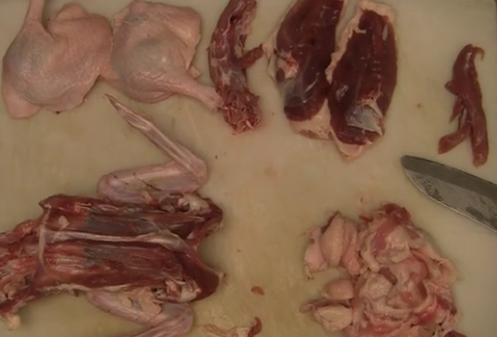Nose-to-tail eating sounds like a trend, but it’s really just good practice. Indeed, even before British chef Fergus Henderson made “whole beast” cooking popular, the whole animal was getting used. Slaughterhouses big and small make sure to use every bit of every animal — that’s how they make their money: livers go into dog food, bones get made into gelatin, etc. The real treat of nose-to-tail is more about getting the whole animal onto your plate. And that comes down to a matter of supporting your farmer. They make more money selling a half a pig or a few ducks directly to consumers and chefs than they do selling their animals to processing plants, which cuts it all up and sends the different pieces off to supermarkets, pet food processors, and who knows where else.
This week’s episode explores the pleasure of using the whole animal in the home kitchen. The tender “center cuts” (breast, tenderloin, etc.) are not the only parts worth eating; in fact they are often not even the best. In the case of duck, it’s a great gateway cooking experience to full on nose-to-tail: all of the parts are delicious and easy to prepare, it just takes a little time. Watch this video to see ducks turned into sausage, pate, rillette, stock, prosciutto, and confit (recipe below):
Here’s the recipe for duck confit:
6 duck legs
3 each of gizzards, hearts, and neck
6 tablespoons of salt
1 teaspoon ground black pepper
1 clove of garlic minced
3 sprigs of thyme minced
1 ground clove star annise
1 teaspoon ground fennel seed
3 ground juniper berries
1 tablespoon brown sugar
4 cups duck fat
Combine the salt with all of the spices. Rub them into the duck legs and make sure it is equally distributed. Cover in plastic wrap and leave.
After 24 hours, rinse the salt mixture off the meat and dry each part. Set in a high pan or casserole dish. Heat up the duck fat and pour it over the legs and other bits. Cover the pan with tinfoil and cook in the oven at 180-200 degrees for 8 hours.
Remove the duck from the oven, and take off the tinfoil. Let cool in refrigerator. This will last for several weeks and will even improve with time.
Serve the hearts, gizzards, and neck sliced at room temperature in a salad, or mixed in with pasta or risotto. For the confit leg, crisp in a pan and serve with kale and lentils, or a salad of bitter greens.



